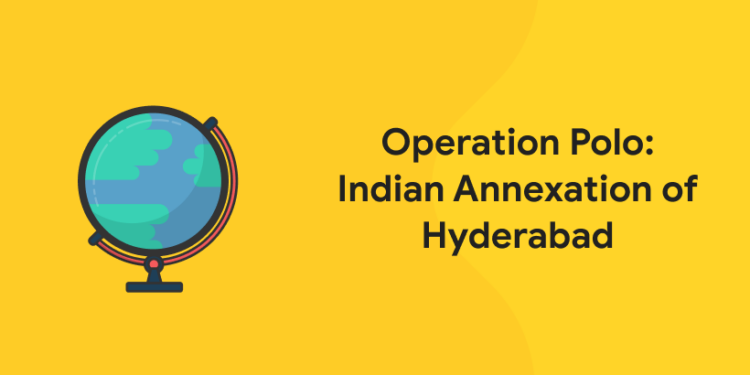Table of Contents
Operation Polo was the nick name for the September 1948 “police action” against Hyderabad state to annex Hyderabad into the India Union. It was a military operation during which the country’s armed forces attacked and annexed the Nizam-ruled princely state. Indian Army, on the instructions of the then Home Minister Sardar Patel, encroach upon Hyderabad on September 13, 1948, and completed the operation in 5 days, i.e. by September 17. Sardar Patel had major uncertainty about the Nizam of Hyderabad’s goals due to the state’s location. Hyderabad state was in the heart of India, surrounded by Independent land. The Nizam was not interested in forming relations with India, which implied he had other intention in mind. As a result, the Home Minister put up an inquiry team to find out what the Nizam was up as it seemed like Hyderabad was friendly with Pakistan and opposed to India.
Against the ‘Standstill Agreement’, Hyderabad had promised to provide Pakistan Rs 20 crore. Pakistan wanted to use the money to buy weapons and ammunition for a war against India over Kashmir. In a sense, the Nizam of Hyderabad was helping Pakistan in its fight against India. Hyderabad was forced to delay the loan sanction to Pakistan until this agreement ended.
Grab study materials to strengthen your GK !!! Register Now !!!
Why was it named Operation Polo?
The Indian Army’s campaign was called Operation Polo because to the fact that Hyderabad during that period had the highest number of polo fields in the world.
Historical context during the partition in 1947, the princely kingdoms of India, which had essentially self-government within their own borders, were bound by supportive agreements with the British, which gave the British control over their exterior ties. The British discontinued all such agreements in 1947, allowing the states to decide for their full independence. By 1948, nearly all these states had succumbed to either India or Pakistan. One exception was Hyderabad, where the a Muslim king Nizam, Mir Sir Osman Ali Khan, Asaf Jah VII, controlled over a predominantly Hindu population, chose independence and wanted to maintain it by an irregular force drawn from the Muslim elite known as the Razakars. However, the Nizam faced the Telangana rebellion, which he was unable to crush.
Grab study materials to strengthen your GK !!! Register Now !!!
Uprising of Telangana
Late 1945 saw peasant rebellion led by communist in Telangana. Various groups supported the communists. The poor peasants disliked the jagirdari system, which controlled 43%of the land. In the beginning help came from wealthy peasants fighting for the communist cause, but by 1948 the union had collapsed. According to the Deputy Director of the Indian Intelligence Bureau, “The communists decreased rates, redistributed land and animals, stopped forced labour, and increased net income by 100%. Geting rid of untouchability was one of their aims. They immunized the community and built public latrines.
Earlier the communists targeted the zamindars and even Hindu Deshmukhs, before launching a full-scale revolution against the Nizam. In the mid of 1946, the Razakar-Communist battle became progressively violent, with both sides using increasingly brutal tactics. Fear of Communist state and acquisition, Hyderabad signed an agreement with the dominion of India in November 1947, preserving all prior agreements except for the stationing of Indian soldiers in the state. Hyderabad broke the agreement in all areas: foreign affairs, communications and defence meddling with border and railway trade, and secretly loaning Pakistan 15 million pounds. The authorities of the new Dominion of India were fearful of India becoming Divided if Hyderabad continued with its independence. According to author AG Noorani, Indian PM Jawahar Lal Nehru was preoccupied with ending to what he referred to as Hyderabad’s “secessionist effort,” but he preferred negotiations and took military action as a last choice. On the contrary Home Minister Sardar Patel, did not go for negotiations, and ordered the capture and annexation of Hyderabad. India invaded the Hyderabad on 13 September 1948, following a destructive economic action, fearful of the formation of a Communist state and the rise of violent Razakars in Hyderabad. The Nizam then signed an agreement thereby joining India.
History behind Operation Polo
1: Who was the first woman President of India?
After the partition of India in 1947, the princely states governed their land themselves but they were still under the Subsidiary Alliance system that gave the British power over their external affairs.
Indian Independence Act 1947, cancelled the policy of subsidiary alliances and the princely states were given 3 choices to decide their future:
- Submit to India
- Submit to Pakistan
- Remain Independent
By 1948 many of the Princely States had united with India but the state of Hyderabad had decided to stay Independent.
Hyderabad was under the Nizam, Mir Sir Osman Ali Khan, Asaf Jah VII. He governed over a largely Hindu population hoping to maintain his independence with a irregular army largely belonging to Muslim aristocracy, called Razakars. India was not comfortable on allowing a wealthy and powerful princely state be left on its own.
Events within Hyderabad, such as the Telangana uprising and militant Razakars gave way to fears of instability in the region. Therefore, the Government of India decided to undertake a military operation to annex Hyderabad.
Grab study materials to strengthen your GK !!! Register Now !!!
Events that occurred before Operation Polo
The Nizam of Hyderabad at first met the British Government with the proposal to form Hyderabad as a constitutional monarchy within the Commonwealth of Nations. The proposal was disapproved by , Lord Louis Mountbatten, the last viceroy of India.
In spite of the British disapproval, the Nizam began discussions with officials from European nations and even tried to buy Goa from the Portuguese so that Hyderabad would have access to the sea.
Although PM Jawahar Lal Nehru tried to defeat Hyderabad’s secessionist ventures through talks, the then Home Minister Sardar Vallabhai Patel sought military means to solve this issue.
The Razakars under Syed Kasim Rizvi were becoming powerful in the Hyderabad state, succeeding that of the Nizam himself. Favouring an independent state with Muslim control in mind, the Razakars under his orders began to extinguish all opposition including Congress members, Telangana rebels, communist and other Muslim moderates who did not agree with his extremist views.
- The Nizam also made failed attempts totake help of the United Nations.
- The Razakars also generateda wave of communal violence forcing most of the Hindu residents of Hyderabad to take refuge in the neighboring states.
Soon after these events, a clash between the Indian army and the Hyderabadi forces at Kodad encouraged the Home Minister to go forward with the police action against Hyderabad.
The date for the attack was decided to be 13 September, even after the objects from General Sir Roy Bucher, the Indian chief of staff, on grounds that Hyderabad would be an added front for the Indian army after Kashmir.
Grab study materials to strengthen your GK !!! Register Now !!!
Operation Polo, 1948
- On 13 Sep1948 , Indian army entered the state at 4 a.m. The first war was fought at Naldurg Fort on the Solapur Secunderabad Highway between a defending force of the 1st Hyderabad Infantry and the attacking force from India of the 7th Brigade.
- Utilizing the combo of speed and surprise, the Indian military unit defeated the poorly armed Hyderabadi forces and secured Naldurg fort.
- The first day on the Western front ended by the Indians bringing down heavy victims from Hyderbad and capturing large areas of territory.
- On September 14, They had camped at Umarge moving forward to the town of Rajeshwar, 48 km east. As aerial intelligence had shown well invulnerable ambush positions set up along the way, the air attacks from air unit of Tempest aircrafts were used. These air strikes helped in clearing the route and allowed the armed forces to reach and concur Rajeshwar by noon.
- Leaving around 3 – 11 Gurkhas to attack the town of Jalna, the remaining force moved to Latur, and later to Mominabad where they faced action against the 3 Golconda Lancers who faught before surrendering on September 15
- Most of the apposition wasfrom Razakar units who attacked the Indians as they passed through urban areas. The Razakars were able to overcome the Indian force until the Indian force brought in their 75 mm guns. The militaty managed surrender the Razakers into submission by 16 september.
- On 17 September, the Indian army entered Bidar in the morning. On the other end, forces led by the 1st Armoured regiment were at the town of Chityal about 60 km from Hyderabad, while the third column managed to take over the town of Hingoli.
It was clear that the Razakars along with the Hyderabadi military were dispatch on all fronts with heavy losses. At 5 pm on 17 September, the Nizam announced a ceasefire, thus leading the armed action to end.
Grab study materials to strengthen your GK !!! Register Now !!!
Consequence of Operation Polo
The Indian military detained 1000’s of victims during the operation, including Hindu militants, Razakars and communists.
on 18 September when the General Joyanto Nath Chaudhuri led an armored column into Hyderabad at around 4 p.m, the Hyderabad army, led by Major General El Edroos, surrendered.
This was largely done on the basis of local perceivers, who used this chance to settle scores. The estimated number of people detained was close to 18,000, which resulted in overcrowded jails and a in efficient criminal system.
The Nizam had resigned upon the surrender of Hyderabad and the princely state discontinued to exist. Subsequently, the Nizam signed an instrument of accession, uniting Hyderabad with India.
Free UPSKILLING Courses!
Take your first step toward mastering in-demand skills, acing interviews, and securing top-tier jobs with Entri's free upskilling courses.
Start Learning!Operation Polo – Indian Annexation of Hyderabad: Quiz
1. What was the code name of the military operation conducted to annex Hyderabad into the India Union?
a) Operation Nizam
b) Operation Diamond
c) Operation Polo
d) Operation Bluestar
Ans (c) Operation Polo
2. Operation Polo’ was related to which of the following?
a) Arrest of Jawaharlal Nehru during the Quit India Movement
b) Invasion of Indian National Army over British India
c) Freedom struggle of Goa against the Portuguese
d) Annexation of Hyderabad Princely State by the Government of India
Ans (d) Annexation of Hyderabad Princely State by the Government of India
Attempt free GK Mock Test! Download Entri App!
3. Which operation was carried out by Sardar Patel to make Hyderabad State a part of the Indian Republic?
a) Operation Polo
b) Operation Blue Star
c) Operation seize
d) Operation Unity
Ans (a) Operation Polo
4. In which year did Operation Polo take place?
a) 1947
b) 1948
c) 1949
d) 1950
Ans (b) 1948
5. Who was the major general that carried out operation polo in Hyderabad?
a) Dalbir Singh Suhag
b) Bipin Rawat
c) JN Chaudhary
d) Deepak Kapoor
Ans (c) J N Chaudhary
I hope this article was helpful. The key point to clear an exam lies in methodical and planned preparation. If you are a candidate who wants to pursue your dream career and looking for a good start, our Entri app has got it covered for you. Our team will help you with content and insights related to the topics of your concern. Subscribe to our app today and enrol yourself into various programmes our app offers. Tune in to the app to stay updated regarding various aspects of the subject you are interested in. Feel free to post any queries and doubts in the comment section. We will try our best to reach out. Push away all those self-doubts and negative thoughts. Try to have a clear vision. Ask yourself why you want this. Focus on the good and work hard. There is a saying that goes like this, Get up and set your shoulders to the wheel-how long is life for you? as you have come to this world leave some mark behind or where is the difference between your trees and stones they too come into existence decay and die. Each day is a precious gift bestowed upon us so make it count. Work on yourself. Stop procrastinating. Today is the day, hope for the best. Good luck.













